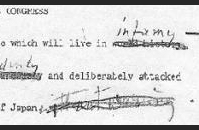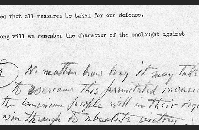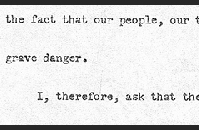LESSON PLAN:
A Day of World History Infamy: Analyzing FDR's Pearl Harbor Address
The attack on Pearl Harbor on December 7, 1941, shocked the nation and led to a declaration of war by the United States against Japan the following day. In asking for this declaration, President Franklin Delano Roosevelt gave a monumental address to Congress and the American people. He knew that this speech would be one of the most important in American history. It is widely known as the “Day of Infamy” speech and is replayed numerous times every year on the anniversary of the attack. However, the word “infamy” was not in the original draft of Roosevelt’s speech. He inserted it in place of the words “world history.” The change in tone that resulted has helped this speech remain one of the most famous in American history.
Objective:
Students will determine the meaning of words selected by FDR as he edited the draft of his December 8, 1941 address to Congress following the Japanese attack on Pearl Harbor.
Grade Level: 6-12
ELA Common Core Standards:
This Lesson meets the “Craft and Structure” component of the Common Core Standards under Literacy in History/Social Studies at each grade level.
RH.6-8.4-6
RH.9-10.4-6
RH.11-12.4-6
History Standards:
History Thinking Standards 2 and 3—the student comprehends a variety of historical sources and engages in historical analysis and interpretation.
Content Era 8 (1929-1945)—the student understands the causes and course of WWII, the character of the war at home and abroad, and its reshaping of the U.S. role in world affairs.
Time Requirement: One class period.
Download a printable pdf version of this lesson plan
Directions:
1. Play the abbreviated version of FDR’s “Day of Infamy” speech available at http://www.archives.gov/education/lessons/day-of-infamy/images/infamy-radio-address.wav
2. Distribute or display the attached draft of FDR’s “Proposed Message to The Congress.”
3. Have students note the handwritten changes on the document.
4. Explain that this is an instance of editing for meaning, tone, and clarity. Review/introduce these terms.
5. Students will be asked to evaluate the changes made to the original draft of the document and how they affect the meaning, tone, and clarity of the document.
6. Using the first example of substituting the word “infamy” for “world history” discuss with your students the impact of the change. Is one word choice better than the other? Why or why not?
7. Distribute and have students complete the Artifact Reading Guide appropriate for your grade level (included).
8. Play the full version of the “Day of Infamy” speech while students have their draft copies with them
http://research.archives.gov/accesswebapp/faces/showDetail?file=Item_1436350.xml&loc=261 (Speech begins at the 1:54 mark, or let it play through to assist with the setting.)
![]()
Assessment:
Assessment will include the artifact reading guide that demonstrates their understanding of meaning, tone, and clarity.
Enrichment:
The National WWII Museum has launched My Town Remembers WWII: An Interactive Photo Contest. Pearl Harbor marked the beginning of U.S. military involvement in World War II. For the next four years, Americans would be involved in the armed forces, in production jobs, and conservation on the Home Front. The war touched every community, and every community has some way of memorializing these efforts. The National WWII Museum wants to know how WWII is honored in your town. It could be a landmark named after a WWII hero, a plaque on a factory that made material essential for the war, or a museum or historical society that contains artifacts from WWII. Find out how your students can participate and view an Interactive Map showcasing submissions!
Supplemental Classroom Materials:
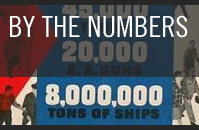
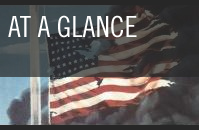
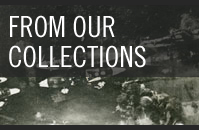
Charts Explaining the Casualties on December 7, 1941 |
A Concise Historical Overview of Pearl Harbor |
Photographs and Video from the Museum's Collection |
FDR's "Proposed Message to Congress":
Day of Infamy Artifact Reading Guide—High School
President Franklin Delano Roosevelt prepared to give a monumental address to Congress and the American people on December 8, 1941 describing the attack on Pearl Harbor and asking Congress for a declaration of war against Japan. He knew that this speech would be one of the most important in American history. Therefore, his word choice was of great importance. Using the draft copy of FDR’s “Day of Infamy” address, evaluate his edits and word choice for meaning, tone, and clarity. From this document, choose any 3 of FDR’s edits.
FDR’s edit on the draft of the document. Example: Changed “world history” to “infamy.” |
Was this change for meaning, tone, clarity, or a combination of the 3? |
Using the meanings of the words/phrases, support your choice from column two. |
Did the change strengthen or weaken the speech? Why or how? |
|
|
|
|
|
|
|
|
|
|
|
|
Day of Infamy Artifact Reading Guide—Middle School
President Franklin Delano Roosevelt prepared to give a monumental address to Congress and the American people on December 8, 1941 describing the attack on Pearl Harbor and asking Congress for a declaration of war against Japan. He knew that this speech would be one of the most important in American history. Therefore, the meanings and tone of his words were of great importance. Using the draft copy of FDR’s “Day of Infamy” address, identify the changes in meaning and tone with his edits.
Meaning
1. "Simultaneously" to "Suddenly"
Definition of "Simultaneously":
Definition of "Suddenly":
Why did he make the change?
Tone
2. "Diplomatic negotiations must be considered at an end” to “Seemed useless to continue the existing negotiations”
Tone of “must be considered at an end”:
Tone of “Seemed useless to continue”:
Why did he make the change?
Clarity
3. Adding “at the solicitation of Japan” to the first line of the second paragraph
Meaning of "solicitation":
Why did he make the change?
Download a printable pdf version of this lesson plan
TAKE ACTION:


EDUCATION PROJECTS:
Student Travel – WWII Educational Tours
High school and college students, learn the leadership principles that helped win WWII on a trip to France or during a weeklong residential program in New Orleans. College credit is available, and space is limited.
See You Next Year! HS Yearbooks from WWII
Collected from across the United States, the words and pictures of these yearbooks present a new opportunity to experience the many challenges, setbacks and triumphs of the war through the eyes of America’s youth.
The Victory Gardens of WWII
Visit the Classroom Victory Garden Project website to learn about food production during WWII, find lesson plans and activities for elementary students, get tips for starting your own garden and try out simple Victory Garden recipes!
The Science and Technology of WWII
Visit our new interactive website to learn about wartime technical and scientific advances that forever changed our world. Incorporates STEM principles to use in the classroom.
Kids Corner: Fun and Games!
Make your own propaganda posters, test your memory, solve puzzles and more! Learn about World War II and have fun at the same time.


